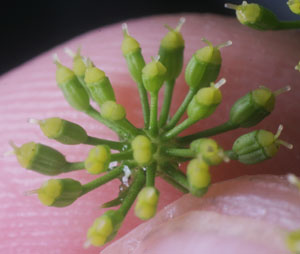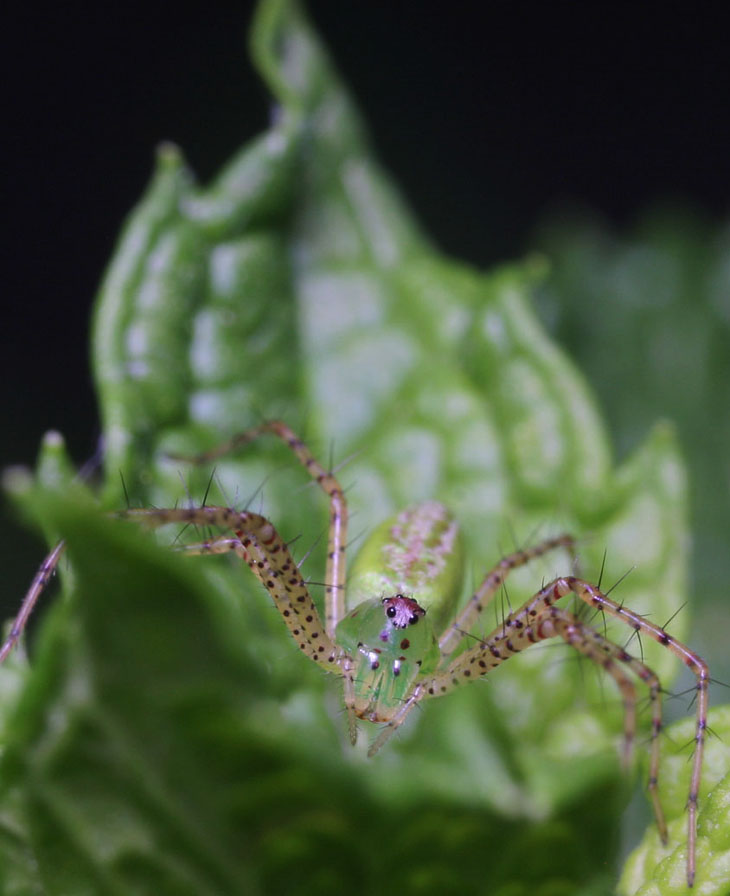
 On Saturday, I was chasing bug pics when I got an expected call to meet with friends, and snagged one frame of some amorous flies on the parsley flowers before I had to put down the camera (sacrilege I know) and head off. I couldn’t see these eyes in the viewfinder (for the reason illustrated at right,) so the surprise came much later when I unloaded the memory card.
On Saturday, I was chasing bug pics when I got an expected call to meet with friends, and snagged one frame of some amorous flies on the parsley flowers before I had to put down the camera (sacrilege I know) and head off. I couldn’t see these eyes in the viewfinder (for the reason illustrated at right,) so the surprise came much later when I unloaded the memory card.
Now, the big question: why do the eyes look like that? What function could this possibly serve? And the big answer: I DON’T KNOW. (Sorry, that was the only way I could make such a wimpy answer “big.”) No source that I’ve uncovered yet has the faintest explanation for why Orthonevra nitida should have such a pattern.
So the amateur naturalist in me starts to speculate ignorantly and wildly in lieu of contacting as many entomologists as I can find in the hopes of uncovering something reputable (that’s the kind of mood I’m in right now.) And so, three things come to mind:
- It has a camouflage function;
- It is a sexual display;
- It provides some specific function to sight, unique to this species.
The first seems a bit suspect, insofar as finding any pattern like that elsewhere strikes me as unlikely, plus the idea that the eyes depart radically in appearance from the rest of the body. The second is also questionable, since this is not a sexually dimorphic species – males and females appear the same. It might, however, serve a purpose in differentiating a compatible mate from similar species, such as O. bellula and O. flukei, both of which have patterns but not this pattern. The biggest problem with this is it supposes the species diverged enough to create distinctive genetic variations that were beneficial (such as favoring plants indigenous to the different geographical areas where they had spread) but not enough to prevent intermingling of the separate species that had developed. Those are mutually exclusive.
The third option, so far, is the one showing the greatest evidence. In a paper by H.L. Leertouwer and D.G. Stavenga, it’s been demonstrated that pigmentation in the upper layers of the eyes affects what wavelengths of light are reaching the optical sensors below – in essence, color filters for portions of the compound eyes. No particular surprise, yet what this would mean is that portions of the compound eyes would have different functions – basically, vision in certain directions would be different from others. Vision straight up might be adapted to avoiding predators, while that nearer the mouthparts could be dedicated to identifying food.
Which doesn’t help much with this funky pattern. Horizontal lines, for instance, may help with horizon sensing for flight, while a radiative/starburst pattern might assist in helping an insect “zero in” on a target. About the only thing I’ve come up with, so far, is that the pattern presents numerous areas of near-equal spacing, which might provide some kind of measuring function. Compound eyes are peculiar things, essentially a collection of tubes radiating out from a common point. They have fixed lenses at the top and each tube can see only a tiny portion or the surroundings, so the optical nerves at the base of each tube give “object in precisely this direction” information to the insect’s brain. Lateral motion is easy for them to differentiate, but something moving directly towards their eyes only becomes obvious when its increasing size impinges on more of the tubes. So for a “measuring” function to be valid, it would have to be in a situation where the proximity to the subject was known, alighting on a flower head for example, and then the fly could determine which stamen or whatever was the ideal size to provide food. All of this assumes that the pigmentation really does provide a specific difference in optical transmission, which it may not. Mysteries of the ages…
Arachnids, on the other hand, have eyes with moving lenses that are much more similar to our own than compound eyes are, so the subject below was likely quite well aware of how close I was looming, but the slow advance wasn’t right to trigger her instincts to seek cover – I’ve seen the difference between hasty movements while much further away and the gradual increase in proximity I used for this image. Then again, maybe she just preferred a full-face shot or liked the ominous effect. Either way, I have to be careful when picking the spearmint…





















































